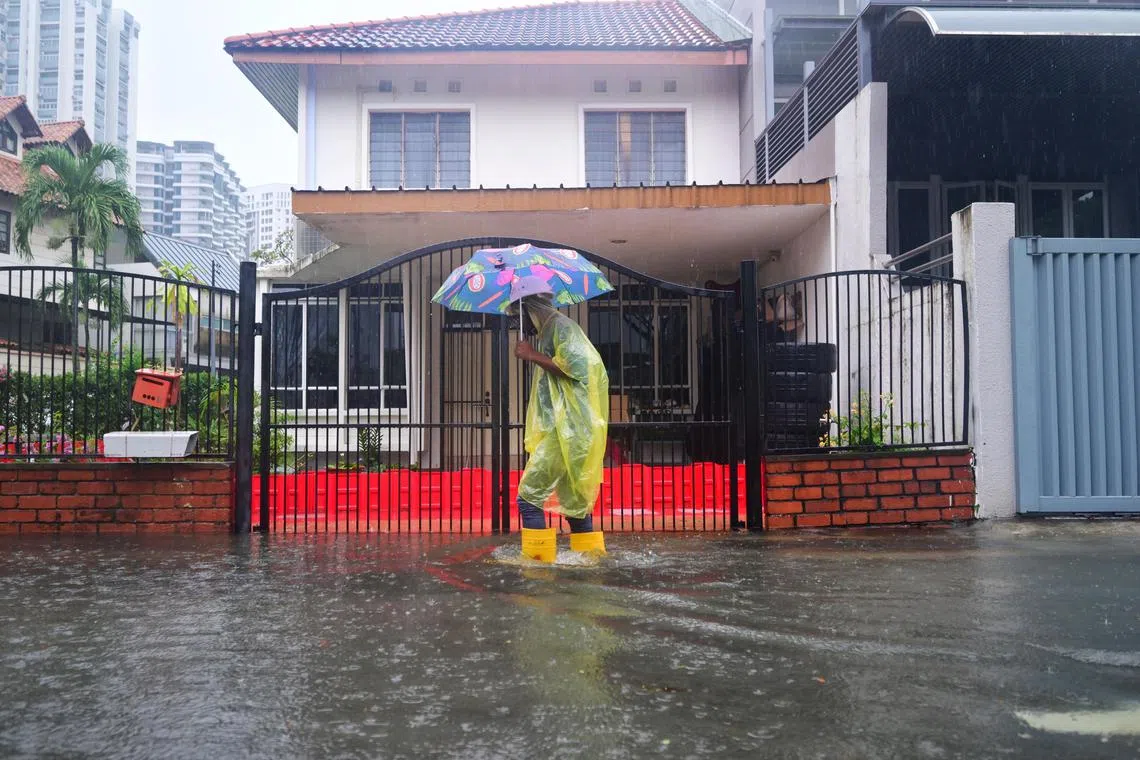Hazard alerts among climate adaptations with big investment potential: Report
Sign up now: Get ST's newsletters delivered to your inbox

With the impact of rising temperatures and extreme weather events intensifying, the market for climate adaptation and resilience solutions will only continue to grow.
PHOTO: ST FILE
Follow topic:
SINGAPORE – Hazard warning systems, flood pumps and barriers, as well as emergency medical services, are among the solutions identified in a new report as having the most investment potential over the next five years, as the world prepares to grapple with the impact of climate change.
The May 7 report by global management consultancy BCG and Singapore’s investment firm Temasek shows that expenditure for climate adaptation and resilience is projected to rise to between US$500 billion (S$646 billion) and US$1.3 trillion a year by 2030.
Financing for climate adaptation projects currently stands at around US$76 billion a year, with governments accounting for most of it, the report noted.
But the growing need to deploy such solutions to cushion people from climate impact is triggering the creation and growth of companies working to develop, deploy and scale climate-related innovations worldwide, said the authors.
This presents an opportunity for investors.
The 36-page document, released during the Temasek-convened sustainability conference Ecosperity Week, adds to the growing momentum among the global climate community to make a business case for climate adaptation – often the less funded prong of climate action, as compared with emissions-cutting activities.
Singapore sovereign wealth fund GIC had on May 2 released another report pointing to the US$9 trillion investment opportunity
The release of planet-warming emissions into the atmosphere from human activities, such as burning fossil fuels, is causing changes in weather patterns and fuelling extreme events, such as wildfires, floods and rising sea levels.
Adaptation represents efforts to reduce the impact of these changes on societies, lives and livelihoods. This could include building sea walls to keep out sea-level rise or embarking on greening efforts to reduce urban temperatures.
Speaking on May 7 during a panel discussion on investing in climate adaptation and resilience at Ecosperity Week, BCG managing director and partner Daniel Oehling, the lead author of the report, said it aims to debunk two key misconceptions that investors have about the adaptation sector.
He added that many investors believe there is a lot of ambiguity and complexity about this sector, making it hard to navigate.
“There is also a misconception that this is still a very early-stage industry and, as such, the companies are early stage, are small, are not profitable today, have high technological risk, and hey – it’s not investable for a lot of private investors,” he said.
“But what our work has shown is that actually both of these misbeliefs are not true,” Mr Oehling added. There is a sizeable market for such investments today, he said, noting: “They are highly profitable, and they are companies that you can act on as an investor.”
The BCG and Temasek report identified seven areas where climate change is currently having the greatest impact – food, infrastructure, health, businesses and communities, water, energy, and biodiversity.
The authors looked at the groups of solutions that can help to reduce the impact of climate change on these sectors, and zoomed in on specific solutions that exist or are being developed.
For example, the report pinpointed “climate-adapted agricultural inputs” as helping to improve the resilience of food systems. It cited specific examples of such input, such as climate-resilient seeds and crop varieties.
The investment opportunity of six “families” of solutions is further elaborated on in the report.
They are climate intelligence solutions such as hazard warning providers or catastrophe risk modelling, climate-resilient building materials, flood defence solutions, urban and industrial water efficiency, emergency medical products and services, and climate-adapted agricultural input.
These sectors, noted the report, are expected to grow by between 4 per cent and 15 per cent over the next five years.
Climate intelligence solutions, in particular, have the highest growth potential of around 15 per cent. Flood defence solutions have a growth projection of between 7 per cent and 10 per cent, while emergency medical products and services are expected to grow by between 8 per cent and 10 per cent.
With the impact of rising temperatures and extreme weather events intensifying in the future, the market for climate adaptation and resilience solutions will only continue to grow, the authors noted.
“By investing in this space, private equity firms can position themselves to capture a rapidly expanding market and contribute to global climate resilience across industries, communities and ecological systems,” BCG and Temasek said.
“By acting now, investors can help build a more resilient world while securing a stake in one of the defining markets of the future.”
Singapore is moving to counter climate change. For instance, studies are ongoing to determine the best sea-level-rise protection efforts for different segments of the coastline. The Republic is cushioning food supply chain shocks by diversifying import sources and increasing the capacity of local farms.
The 11th edition of Ecosperity Week gathers business leaders, policymakers, investors and civil society to discuss how Asia’s efforts to tackle climate change can be accelerated.
Audrey Tan is an assistant news editor overseeing sustainability coverage. She has reported on the environment for more than a decade and hosts the Green Pulse podcast series.


